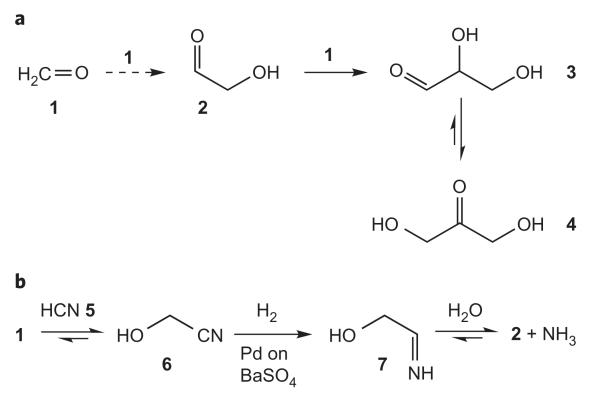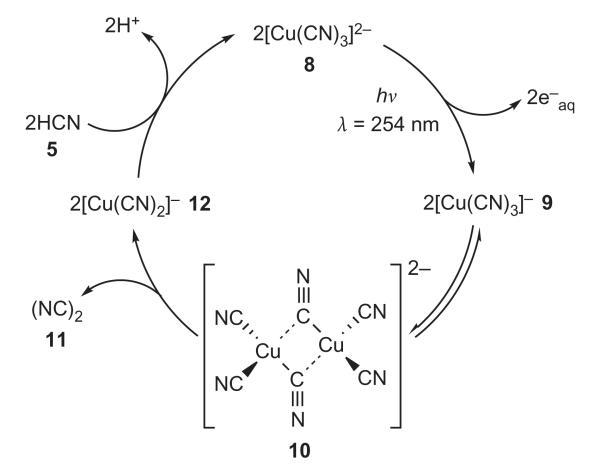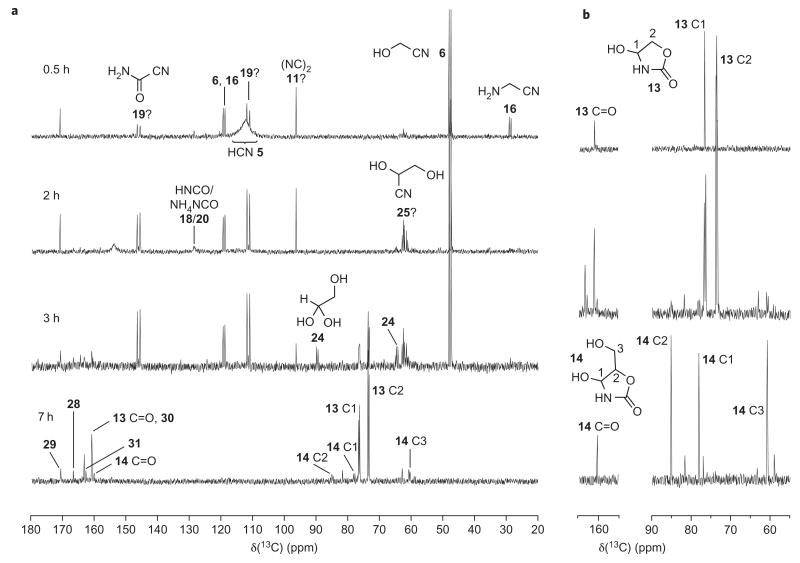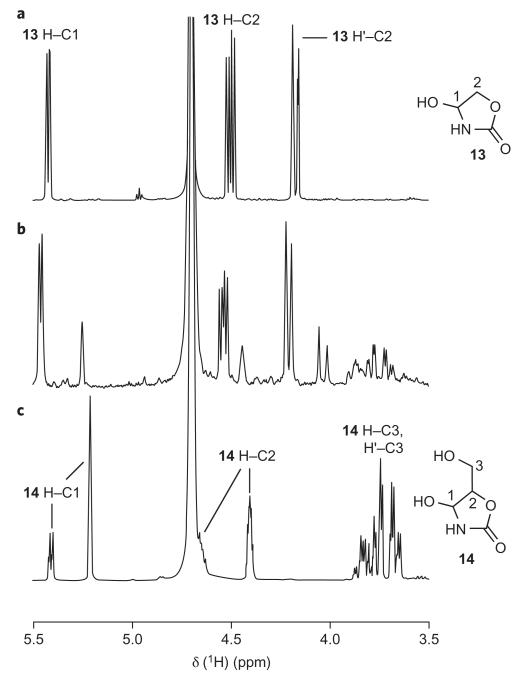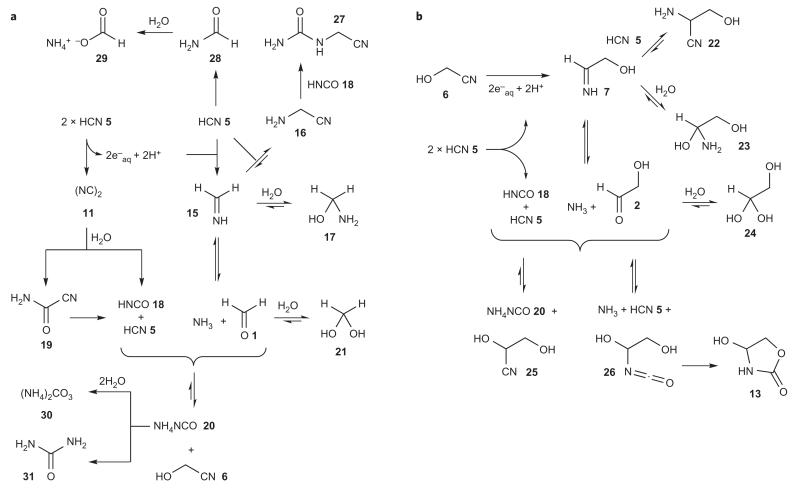Abstract
A recent synthesis of activated pyrimidine ribonucleotides under prebiotically plausible conditions relied on mixed oxygenous and nitrogenous systems chemistry. As it stands, this synthesis provides support for the involvement of RNA in the origin of life, but such support would be considerably strengthened if the sugar building blocks for the synthesis—glycolaldehyde and glyceraldehyde—could be shown to derive from one carbon feedstock molecules using similarly mixed oxygenous and nitrogenous systems chemistry. Here, we show that these sugars can be formed from hydrogen cyanide by ultraviolet irradiation in the presence of cyanometallates in a remarkable systems chemistry process. Using copper cyanide complexes, the process operates catalytically to disproportionate hydrogen cyanide, first generating the sugars and then sequestering them as simple derivatives.
At some point at the origin of life, RNA is thought to have had a catalytic role and to have functioned as the sole purveyor of genetic information1–3. However, until recently4, there has been no demonstration of a prebiotically plausible synthesis of ribonucleotides to support this contention. It had long been thought that nucleobases and ribose should first be formed separately and then conjoin by glycosidation to give nucleosides that could then undergo phosphorylation, but there were two major problems with this approach5. First, the oxygenous chemistry assumed necessary to make sugars seemed incompatible with the nitrogenous chemistry needed to make nucleobases, thus requiring either a spatial separation of the two chemistries followed by a bringing together of the products, or some sort of temporal separation. Second, it had not been possible to demonstrate the ribosylation of the canonical pyrimidine nucleobases, and the ribosylation of purines was very low yielding and gave many isomeric products. We wondered if a mixed oxygenous and nitrogenous chemistry might be synthetically productive if phosphate were included to catalyse certain reaction pathways. Accordingly, we explored mixed systems containing pentose and nucleobase precursor fragments as well as phosphate. This exploration resulted in our discovery of a phosphate-catalysed reaction in which a pentose fragment reacts with a pyrimidine nucleobase fragment to give an intermediate already having the C–N bond destined to become the glycosidic bond of a pyrimidine ribonucleotide4. Subsequent reaction of this intermediate with the remaining pentose and pyrimidine nucleobase fragments gave an anhydronucleoside, which then underwent reaction with phosphate to give an activated pyrimidine ribonucleotide. To extend this synthesis back to simple prebiotic feedstock molecules requires compatible chemistry that furnishes pentose and nucleobase precursor fragments. This Article is concerned with the synthesis of the requisite pentose fragments—two- and three-carbon sugars.
For many decades, the formose reaction—in which formaldehyde 1 is oligomerized in the presence of alkaline earth hydroxides6—has been cited as the prebiotic source of sugars7–9. Conceptually, the formose reaction is one of the simplest syntheses of sugars because it involves iterative homologation starting from formaldehyde 1 (1 → glycolaldehyde 2 → glyceraldehyde 3, and so on; Fig. 1a). However, the intrinsic polarity of the carbonyl group means that its carbon atom is electrophilic, not nucleophilic, so the dimerization of 1 to 2 needs umpolung (polarity inversion)10, which has not been demonstrated in a prebiotic context. The next homologation of 2 to 3 by 1 does not need umpolung because a nucleophilc carbanion can be formed by deprotonation of the carbon atom adjacent to the carbonyl group of 2, and this carbanion can then add to 1. However, under the reaction conditions it is not possible to prevent the base-catalysed conversion of 3 to its more stable isomer dihydroxyacetone 4, then assorted aldol and other reactions ensue, resulting in a plethora of products. The formose reaction therefore has an absolute requirement for initiator glycolaldehyde 2 (ref. 11) and cannot be controlled to give 3, but instead gives a notoriously complex product mixture12. These serious shortcomings have prevented the formose reaction from being universally accepted as the prebiotic synthesis of sugars13,14.
Figure 1. Homologation routes to simple sugars from formaldehyde 1.
a, Direct homologation of formaldehyde 1 is problematic, because the first dimerization step (dashed) requires umpolung, and because the trimer is more stable as the ketose 4 than the aldose 3 under conditions where 3 can be formed from 1 and 2. b, Kiliani–Fischer homologation of 1 in conventional synthetic chemistry involves favourable formation of the cyanohydrin 6 by reaction of 1 with hydrogen cyanide 5, followed by the selective reduction of 6 using very specific conditions.
An alternative iterative homologation process starting from 1 is known in conventional synthetic organic chemistry, however, and it is controlled and efficient. The Kiliani–Fischer synthesis15,16 exploits the nucleophilicity of the cyanide anion and involves homologation via the formation and subsequent selective reduction of cyanohydrins, or their derivatives. In a modern variant of this synthesis17, formaldehyde 1 undergoes reaction with hydrogen cyanide 5 in water to give the cyanohydrin glycolonitrile 6, which is then reduced to glycolaldehyde imine 7 (Fig. 1b). Spontaneous hydrolysis of 7 to glycolaldehyde 2 and ammonia then completes the first homologation. In light of what follows, it is worth considering the chemistry of this homologation process in more detail. Formation of 6 from 1 and 5 is an equilibrium reaction, which lies greatly in favour of 6 (Keq = 4.6 × 105 M−1)18, and is kinetically extremely facile. The reduction of 6 to 7 is achieved by catalytic hydrogenation, but the use of a poisoned catalyst (palladium on barium sulfate) is crucial to prevent the otherwise facile reduction of 7 or 2 (the equilibrium hydrolysis of 7 to 2 and ammonia occurs during the hydrogenation reaction and is rendered effectively irreversible by the protonation of ammonia under the acidic reaction conditions).
The proposed occurrence of hydrogen cyanide 5 on the early Earth is supported by the propensity of this simple small molecule to form when organic matter is bombarded with excess energy19,20, and by its widespread presence in the solar system and beyond in comets, the atmospheres of planets and their satellites, and in the interstellar medium21–24. Furthermore, 5 is strongly implicated in prebiotic chemistry20, mainly because of the essential role it plays in the Strecker synthesis of amino acids25 and the Oró synthesis of adenine26. Accordingly, we wondered if the key cyanohydrin nitrile group reduction step of the Kiliani–Fischer synthesis could be effected selectively under prebiotically plausible conditions, in which case iterative homologation of formaldehyde 1 with 5 would be possible. If 5 itself could also be selectively reduced and thus converted to 1 we reasoned that it might even be possible to generate sugars starting from 5 as the sole carbon source. The finely tuned conditions of the reduction step in the conventional synthetic organic Kiliani–Fischer synthesis suggested that a prebiotic variant might not be found, but the attractiveness of the overall route, in terms of its simplicity, warranted such a search.
The pulse radiolysis of nitriles—including hydrogen cyanide 5—gives several products resulting from selective nitrile reduction27, but the intermediacy of hydroxyl radicals and hydrogen atoms in addition to hydrated electrons results in a multitude of other products, and the role of radiolysis in prebiotic chemistry is questionable20. We thus considered the photochemical production of hydrated electrons and were immediately drawn to the photochemistry of cyanometallates28,29. In general, the ultraviolet irradiation of these negatively charged transition-metal cyanide complexes in aqueous solution results in the metal ion losing cyanide ligands, electrons or both29. The field has been well studied from both inorganic and physical chemistry points of view, and the likely abundance of such complexes on the early Earth has been highlighted30–32, but, as far as we are aware, little organic chemical attention has been focused on the interaction of hydrated electrons produced in this way with nitriles such as 5 and the cyanohydrin 6.
Results and discussion
As a first foray into this area we chose to study the photochemistry of copper(I) cyanide complexes in aqueous solutions of hydrogen cyanide 5, because we anticipated that this would reveal the basic features of cyanometallate photoredox systems chemistry. Piecing together literature reports33,34, a copper(I) ↔ copper(II) photoredox cycle can be drawn (Fig. 2). On irradiation with ultraviolet light, tricyanocuprate(I) 8 undergoes photooxidation to tricyanocuprate(II) 9, with concomitant production of a hydrated electron. Dimerization of 9 gives the cyano-bridged binuclear complex 10, which then reductively eliminates cyanogen 11, giving dicyanocuprate(I) 12. Complexation of additional cyanide ions by 12 then regenerates 8 and completes the cycle. The cycle operates with or without hydrated electron scavengers such as nitrate, and in the absence of such scavengers it was noted that relatively large molecules could be detected by mass spectroscopy33. These large molecules were tentatively suggested to be oligomers produced by base-catalysed polymerization of 5. We have repeated this experiment with no added scavengers of hydrated electrons, and examined the intermediates and products by nuclear magnetic resonance (NMR) spectroscopy. In this way we have discovered a remarkable iterative Kiliani–Fischer systems chemistry synthesis of glycolaldehyde 2 and glyceraldehyde 3 that is initiated by the reduction of 5.
Figure 2. Photoredox cycling of copper cyanide complexes in the presence of hydrogen cyanide 5.
Each turn of the cycle results in the oxidation of two molecules of hydrogen cyanide 5 to cyanogen 11, with the concomitant production of two protons and two hydrated electrons. The photoxidation of the tricyanocuprate(I) species 8 to tricyanocuprate(II) 9 is inferred because the corresponding dicyanocuprate(I) is not photoactive at 254 nm, and, according to stability constant calculations, the tetracyanocuprate(I) is a very minor species33. Dimerization of 9 to the binuclear complex 10 and reductive elimination of cyanogen 11 giving dicyanocuprate(I) 12 is suggested by the kinetics of the decomposition of copper(II) cyanide complexes34. Finally, conversion of dicyanocuprate(I) 12 to tricyanocuprate(I) 8 is suggested by the aforementioned photoinactivity of 12 and stability constant data, and the fact that a cycle is clearly operative.
13C-labelled potassium cyanide and catalytic copper(I) cyanide were dissolved in H2O containing 10% D2O by volume, and the resultant solution was thoroughly deoxygenated by sparging with argon gas before being neutralized by the addition of hydrochloric acid. The solution was irradiated at 254 nm in a quartz cuvette for a fixed period of time, transferred to a standard NMR tube for 13C-NMR analysis, and then returned to the cuvette for further irradiation. 13C-NMR spectra taken during the irradiation (Fig. 3a) reveal that the system grows and then diminishes in complexity. The reaction had finished after 7 h, at which point the 13C-NMR spectrum indicated that a remarkably simple palette of products had been formed. The spectrum had several multiplet signals, indicating that 13C–13C bonds had been formed during the reaction, as well as some singlet signals. We suspected that the multiplet signals were due to 13 (ref. 35) and 14, the oxazolidinone derivatives of glycolaldehyde 2 and glyceraldehyde 3, respectively. Oxazolidinone derivatives are formed from sugars by reaction with cyanate salts36, and so we acquired natural abundance 13C-NMR spectra of the crude reaction products of commercially available 2 and 3 with excess potassium cyanate (Fig. 3b, upper and lower) and compared these to the 13C-NMR spectrum of the photochemical reaction products after 7 h irradiation (Fig. 3b, middle). This comparison strongly supported our product assignments. To obtain further support, a second photochemical reaction was carried out starting with unlabelled potassium cyanide, and using H2O with no added D2O as solvent so that the products would be completely protiated, and therefore best suited for analysis by 1H-NMR spectroscopy. This reaction was performed without sampling and analysis during the intermediate stages, and after 8 h the reaction mixture was lyophilized, and the residue was taken up in D2O for 1H-NMR analysis (Fig. 4b). Comparison of the spectrum of the irradiation products with the reference 1H-NMR spectra for 13 and 14 (Fig. 4a,c) and other NMR data (Supplementary Figs S12 and S13) leave little room for doubt that the major irradiation products are 13 and 14.
Figure 3. 13C-NMR analysis of the organic intermediates and products formed by the photoredox cycling of copper cyanide complexes in the presence of hydrogen cyanide 5.
a, Time course analysis showing the complexity of the system increasing and then decreasing. Question marks indicate inferred assignments. b, Enlargement of the spectrum of the photochemical products after 7 h (middle) compared to the 13C-NMR spectra of 13 (upper) and 14 (lower), the products of reaction of potassium cyanate with glycolaldehyde 2 and glyceraldehyde 3, respectively.
Figure 4. 1H-NMR analysis of photochemical products.
a–c, 1H-NMR spectrum of the products after an 8 h reaction without intermediary sampling (b) as compared to the 1H-NMR spectra of 13 (a) and 14 (c). Small chemical shift differences are thought to be due to pH differences, and are not seen in spiked spectra (see Supplementary Information).
Mechanistic rationale
The main reaction pathways and intermediates—both inferred and directly observed—are shown in Fig. 5. In the first stage of the reaction (Fig. 5a), the hydrated electrons and protons generated by the photoredox cycle (Fig. 2) reduce hydrogen cyanide 5 to methanimine 15, presumably by way of the methaniminyl radical (CH2=N.)37. In water containing 5, 15 exists in equilibria with glycine nitrile 16, the hemiaminal 17, and with formaldehyde 1 and ammonia38. Meanwhile, the other product of the photoredox cycle, cyanogen 11, undergoes hydrolysis. This hydrolysis is known to proceed by a combination of direct and indirect paths to give isocyanic acid 18 and 5 (ref. 39). The indirect path via cyanoformamide 19 predominates and the conversion of 19 to 18 and 5 is much slower than the direct path. The gradual production of isocyanic acid 18 displaces the various equilibria of 15 in favour of 1 because 18 undergoes an acid–base reaction with ammonia generating ammonium cyanate 20. The formaldehyde 1 thus liberated then participates in new equilibria with the hydrate 21 and glycolonitrile 6, with the latter compound dominating.
Figure 5. Disproportionation of hydrogen cyanide 5 and ensuing systems chemistry.
a,b, The organic chemistry that occurs when the inorganic photoredox cycling of Fig. 2 operates can be loosely described in two stages as in a and b.
The protons and hydrated electrons generated by another turn of the photoredox cycle can either further reduce hydrogen cyanide 5, in which case the first stage of the reaction is repeated, or they can reduce other nitrile species, in which case a second stage ensues (Fig. 5b). In principle, both glycine nitrile 16 and glycolonitrile 6 could be reduced, but it appears that only the latter undergoes reduction, presumably because electron transfer to the most electron-deficient nitrile is favoured and the negative inductive effect of an OH group greatly outweighs that of an NH2 group. Because it is not reduced, 16 then serves as a reservoir of formaldehyde 1, the latter being furnished as 5 is consumed by further turns of the photoredox cycle. Reduction of 6 generates the imine 7, which exists in equilibria with serine nitrile 22, the hemiaminal 23, and with glycolaldehyde 2 and ammonia (Supplementary Figs S15–S20). As ammonia is depleted by an acid–base reaction with isocyanic acid 18, these equilibria are replaced by equilibria between 2 and its hydrate 24 and the cyanohydrin glyceronitrile 25 (Supplementary Figs S18, S21–S24). There is also presumed to be an equilibrium reaction between 2 and its isocyanic acid adduct 26. Although this latter adduct is expected to be a very minor component at equilibrium, it has the chemical potential to undergo irreversible ring closure to the oxazolidinone derivative 13. This ring closure then displaces the various equilibria according to Le Chatelier’s principle and 13 accumulates as the major product of the reaction.
Repetition of the second-stage chemistry, but starting with glyceronitrile 25, gives 14, the other oxazolidinone product observed, by way of glyceraldehyde 3. We find that 14 is always less abundant than 13, as might be expected from the mechanism described above. We think that the variations in the amount of 14 are due to variable losses of hydrogen cyanide 5 during transfer of samples between the reaction cuvette and the NMR tube. Glycine nitrile 16 was almost always observed in spectra acquired during the irradiation and usually in spectra at the end. The volatility of ammonia formed during the reaction means that it is also lost from the system during reaction sampling, and we think this results in variable yields of 16. We have quantitated 13 by integration relative to an added sample of pentaerythritol as standard (see Supplementary Information) and measured a yield of the order of 15% on average based upon a reaction stoichiometry in which four molecules of 5 are required to make one of 13. Yields of 14 are in the range 1–5%. Given the presumed prebiotic abundance of hydrogen cyanide 5, however, we consider the yield of the reaction less important than the highly selective production of only a small number of products in solution (a black solid—presumed to be a polymer of 5—precipitates during the course of the reaction and accounts for ~30% of the input 5).
Finally, we note that other cyanometallates such as hexacyanoferrate(II) undergo photoaquation and photooxidation, but not efficient photoredox cycling29. Thus it should prove possible to generate sugars without subsequent sequestration as cyanate derivatives. If such photochemistry is carried out in the presence of cyanamide and phosphate then a smooth merger with our previously described synthesis of activated pyrimidine ribonucleotides4 might prove possible.
Supplementary Material
Acknowledgements
This work was funded by the Engineering and Physical Sciences Research Council through the provision of a postdoctoral fellowship (to D.R.) and by the Medical Research Council (project no. MC_UP_A024_1009). The authors thank S. Freund and T. Rutherford for assistance with NMR spectroscopy.
Footnotes
Additional information Supplementary information and chemical compound information are available in the online version of the paper. Reprints and permission information is available online at http://www.nature.com/reprints.
Competing financial interests The authors declare no competing financial interests.
References
- 1.Woese C. The Genetic Code. Harper & Row; 1967. pp. 179–195. [Google Scholar]
- 2.Crick FHC. The origin of the genetic code. J. Mol. Biol. 1968;38:367–379. doi: 10.1016/0022-2836(68)90392-6. [DOI] [PubMed] [Google Scholar]
- 3.Orgel LE. Evolution of the genetic apparatus. J. Mol. Biol. 1968;38:381–393. doi: 10.1016/0022-2836(68)90393-8. [DOI] [PubMed] [Google Scholar]
- 4.Powner MW, Gerland B, Sutherland JD. Synthesis of activated pyrimidine ribonucleotides in prebiotically plausible conditions. Nature. 2009;459:239–242. doi: 10.1038/nature08013. [DOI] [PubMed] [Google Scholar]
- 5.Szostak JW. Systems chemistry on early Earth. Nature. 2009;459:171–172. doi: 10.1038/459171a. [DOI] [PubMed] [Google Scholar]
- 6.Butlerow A. Bildung einer zuckerartigen substanz durch synthese. Liebigs Ann. Chem. 1861;120:295–298. [Google Scholar]
- 7.Miller SL, Orgel LE. The Origins of Life on the Earth. Prentice-Hall; 1974. pp. 109–112. [Google Scholar]
- 8.Ricardo A, Carrigan MA, Olcott AN, Benner SA. Borate minerals stabilize ribose. Science. 2004;303:196. doi: 10.1126/science.1092464. [DOI] [PubMed] [Google Scholar]
- 9.Breslow R, Cheng Z-L. On the origin of terrestrial homochirality for nucleosides and amino acids. Proc. Natl Acad. Sci. USA. 2009;106:9144–9146. doi: 10.1073/pnas.0904350106. [DOI] [PMC free article] [PubMed] [Google Scholar]
- 10.Seebach D. Methods of reactivity umpolung. Angew. Chem. Int. Ed. 1979;18:239–258. [Google Scholar]
- 11.Socha RF, Weiss AH, Sakharov MM. Homogeneously catalyzed condensation of formaldehyde to carbohydrates: VII. An overall formose reaction model. J. Catal. 1981;67:207–217. [Google Scholar]
- 12.Decker P, Schweer H, Pohlmann R. Bioids: X. Identification of formose sugars, presumable prebiotic metabolites, using capillary gas chromatography/gas chromatography–mass spectrometry of n-butoxime trifluoroacetates on OV-225 J. Chromatogr. A. 1982;244:281–291. [Google Scholar]
- 13.Shapiro R. Prebiotic ribose synthesis: a critical analysis. Orig. Life Evol. Biosphere. 1988;18:71–85. doi: 10.1007/BF01808782. [DOI] [PubMed] [Google Scholar]
- 14.Eschenmoser A. Etiology of potentially primordial biomolecular structures: from vitamin B12 to the nucleic acids and an inquiry into the chemistry of life’s origin: a retrospective. Angew. Chem. Int. Ed. 2011;50:12412–12472. doi: 10.1002/anie.201103672. [DOI] [PubMed] [Google Scholar]
- 15.Fischer E. Reduction von säuren der Zuckergruppe. Ber. Dtsch Chem. Ges. 1889;22:2204–2205. [Google Scholar]
- 16.Morrison JD, Mosher HS. Asymmetric Organic Reactions. Prentice-Hall; 1971. pp. 133–141. [Google Scholar]
- 17.Serianni AS, Clark EL, Barker R. Carbon-13-enriched carbohydrates. Preparation of erythrose, threose, glyceraldehyde, and glycolaldehyde with 13C-enrichment in various carbon atoms. Carbohydr. Res. 1979;72:79–91. [Google Scholar]
- 18.Schlesinger G, Miller SL. Equilibrium and kinetics of glyconitrile formation in aqueous solution. J. Am. Chem. Soc. 1973;95:3729–3735. [Google Scholar]
- 19.Eschenmoser A, Loewenthal E. Chemistry of potentially prebiological natural products. Chem. Soc. Rev. 1992;21:1–16. [Google Scholar]
- 20.Ferris JP, Hagan WJ., Jr. HCN and chemical evolution: the possible role of cyano compounds in prebiotic synthesis. Tetrahedron. 1984;40:1093–1120. doi: 10.1016/s0040-4020(01)99315-9. [DOI] [PubMed] [Google Scholar]
- 21.Donn B. Comets: chemistry and chemical evolution. J. Mol. Evol. 1982;18:157–160. doi: 10.1007/BF01733041. [DOI] [PubMed] [Google Scholar]
- 22.Tokunaga AT, Beck SC, Geballe TR, Lacey JH, Serabyn E. The detection of HCN on Jupiter. Icarus. 1981;48:283–289. [Google Scholar]
- 23.Hanel R, et al. Infrared observations of the Saturnian system from Voyager 1. Science. 1981;212:192–200. doi: 10.1126/science.212.4491.192. [DOI] [PubMed] [Google Scholar]
- 24.Snyder LE, Buhl D. Observations of radio emission from interstellar hydrogen cyanide. Astrophys. J. Lett. 1971;163:L47–L52. [Google Scholar]
- 25.Strecker A. Ueber einen neuen aus aldehyd-ammoniak und blausäure entstehenden Körpe. Liebigs Ann. Chem. 1854;91:349–351. [Google Scholar]
- 26.Oró J. Synthesis of adenine from hydrogen cyanide. Biochem. Biophys. Res. Commun. 1960;2:407–412. [Google Scholar]
- 27.Niketić V, Draganić ZD, Nešković S, Jovanović S, Draganić IG. Radiolysis of aqueous solutions of hydrogen cyanide (pH ~ 6): compounds of interest in chemical evolution studies. J. Mol. Evol. 1983;19:184–191. [Google Scholar]
- 28.Hartman H. Speculations on the origin and evolution of metabolism. J. Mol. Evol. 1975;4:359–370. doi: 10.1007/BF01732537. [DOI] [PubMed] [Google Scholar]
- 29.Adamson AW, et al. Photochemistry of transition metal coordination compounds. Chem. Rev. 1968;68:541–585. [Google Scholar]
- 30.Orgel LE. In: The Origin of Life and Evolutionary Biochemistry. Dose K, Fox SW, Deborin GA, Pavlovskaya TE, editors. Plenum; 1974. pp. 369–371. [Google Scholar]
- 31.Arrhenius T, Arrhenius G, Paplawsky W. Archean geochemistry of formaldehyde and cyanide and the oligomerization of cyanohydrin. Orig. Life Evol. Biosphere. 1994;24:1–17. doi: 10.1007/BF01582036. [DOI] [PubMed] [Google Scholar]
- 32.Keefe AD, Miller SL. Was ferrocyanide a prebiotic reagent? Orig. Life Evol. Biosphere. 1996;26:111–129. doi: 10.1007/BF01809851. [DOI] [PubMed] [Google Scholar]
- 33.Horváth A, Papp S, Décsy Z. Formation of aquated electrons and the individual quantum yields for photoactive species in the Cu(I)–KCN–H2O system. J. Photochem. 1984;24:331–339. [Google Scholar]
- 34.Katagiri A, Yoshimura S, Yoshizawa S. Formation constant of the tetracyanocuprate(II) ion and the mechanism of its decomposition. Inorg. Chem. 1981;20:4143–4147. [Google Scholar]
- 35.Tavernier D, Van Damme S, Ricquier P, Anteunis MJO. A convenient preparation of 3H-1,3-oxazol-2-one and its N-formyl derivative. Bull. Soc. Chim. Belg. 1988;97:859–865. [Google Scholar]
- 36.Kovács J, Pintér I, Lendering U, Köll P. Transformation of aldoses into glycosylamine 1,2-(cyclic carbamates) (glyco-oxazolidin-2-ones) by reaction with potassium cyanate. Carbohydr. Res. 1991;210:155–166. [Google Scholar]
- 37.Behar D, Fessenden RW. An electron spin resonance investigation of the reactions in irradiated aqueous solutions of hydrogen cyanide and the cyanide ion. J. Phys. Chem. 1972;76:3945–3950. [Google Scholar]
- 38.Moutou G, et al. Equilibrium of α-aminoacetonitrile formation from formaldehyde, hydrogen cyanide and ammonia in aqueous solution: industrial and prebiotic significance. J. Phys. Org. Chem. 1995;8:721–730. [Google Scholar]
- 39.Wang YL, Lee HD, Beach MW, Margerum DW. Kinetics of base hydrolysis of cyanogen and 1-cyanoformamide. Inorg. Chem. 1987;26:2444–2449. [Google Scholar]
Associated Data
This section collects any data citations, data availability statements, or supplementary materials included in this article.



